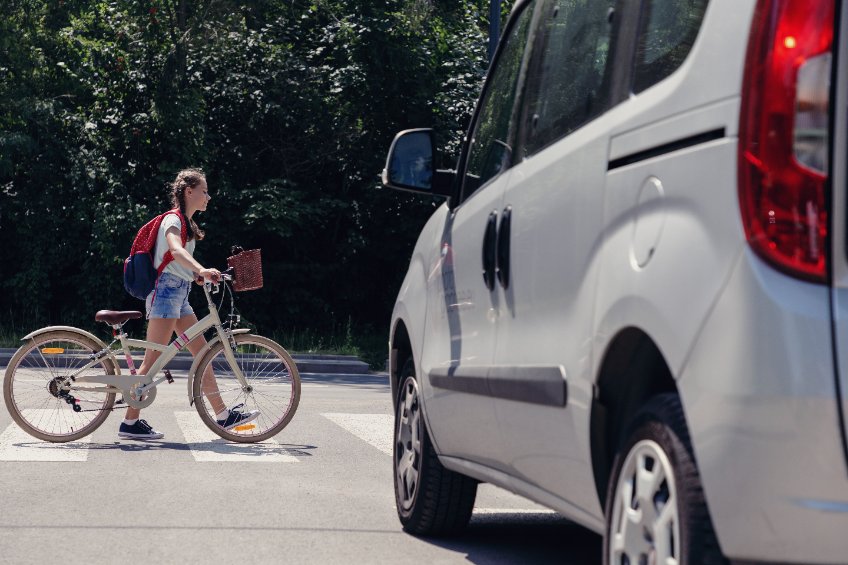
With school back in session in Las Vegas, both drivers and students will need to adjust to the new routine, sharing the road, and getting to and from school safely. The responsibility is on drivers to emphasize school driving safety until everyone gets back into the groove of things in order to prevent accidents. The attorneys at Lerner and Rowe offer the following school driving safety tips to help ensure student safety.
Driving in School Zones
Driving in school zones requires extra caution in order to prevent car accidents. Inattentive students and negligent drivers make for a disastrous combination. Adult drivers must practice proper school driving safety and set a good example for younger drivers. Good drivers will:
- Obey the speed limit in school zones: Nevada school zones have a posted speed limit of 15 miles per hour. Driving the speed limit keeps everyone safe and helps prevent accidents.
- Do not block crosswalks: If you block a portion of a crosswalk, a student might walk past your car and into oncoming traffic.
- Always come to a complete stop: Many drivers execute rolling stops at stop signs instead of completely stopping. Students who are biking or walking to school run the risk of being hurt by rolling stops.
- Avoid distractions: Distracted driving has dramatically increased as mobile phone apps have grown more immersive. Don’t endanger a child’s life by driving while distracted.
- Pay attention to blind spots: It’s crucial to look both ways before reversing in a school zone. A student could be in your blind spot at any time.
School Driving Safety for Bicycles
Many children ride their bicycles to school — some possibly for the first time. Even if your child has previously ridden their bike to school, you should constantly talk to them about bicycle safety. The following tips can ensure that their trip to school is safe and free of bicycle accidents.
Before your child rides off:
- Teach them the rules of the road:
- Ride on the right side of the road, going with traffic, in single file.
- Stop completely before crossing the street and walk the bike across.
- Make sure your child wears a properly fitted helmet with buckles and a chin strap. If the helmet isn’t new, check to see if it is in good condition and fits. While Nevada doesn’t require bicyclists to wear helmets, you should encourage your child to wear one. A helmet will protect your child if they are in an accident. Wearing a helmet can also help prevent catastrophic or brain injuries.
- Teach your children to utilize bike lanes if they are available; if not, sidewalks can be used in Las Vegas, except for Fremont Street, under the Fremont Experience, between Main and Seventh. The only exception is when the Director of Public Works decides that it is necessary to safeguard public safety and forbids bicycle riding on sidewalks. A sign typically warns cyclists about these places. Make sure your child is aware of the rules if they are riding their bike in this area.
- Encourage your children to avoid use of headphones, earbuds, a cell phone, or other devices while they’re on a bicycle. Using these can prevent them from hearing cars, car horns, or emergency vehicles when they are out riding their bikes. They also provide unnecessary distractions which can lead to an accident.
- To avoid congested intersections, find routes and cycle on streets with less traffic. This will help them understand bus and bicycle safety.
- Make sure your child is cautious around locations with driveways, junctions, and parked cars, as these pose unique risks to bikers.
Gear advice:
- Make sure their bike is large enough or small enough to fit their current height/size.
- Ensure their bike has the proper safety gear attached like a red reflector on the back and a white light on front to help drivers see them when visibility is low.
Bicycle Safety to Teach Your Child
- Teach your child to follow the rules of the road and not to take any unnecessary risks like weaving in and out of the lanes or pedaling too fast.
- Help your child plan a main route and alternative route to and from school. Sometimes accidents happen or construction zones block a regular route. Having a regular route will ensure your child won’t get lost. Ride the route with them a few times before they go out on their own to help them feel more comfortable.
More tips:
- Teach your child general bicycle maintenance. Remind them to check their brakes, the chain, and make sure there is enough air in the tires.
- Teach them to ride with the flow of traffic.
- Remind them to examine both sides of the street before crossing at crossings, then walk their bike through if it is safe to do so.
- Always assume drivers cannot see them and remind them to always be cautious of their surroundings.
- Stay away from strangers and never accept a ride or anything that they may try to give them. They should also report the incident to their parents, guardians, and teacher.
- Find a buddy or two to ride with when possible. If someone gets injured, they will have help to get them to safety. They are also less likely to engage in risky behaviors.
School Bus Safety Tips for Children, Drivers, and Parents
While some kids are still enjoying their summer freedom, some parents look forward to school starting again. Preparing for the new school year entails being aware of school buses being back out on the road.
All drivers should also do their part in ensuring every child’s safety, not only while they’re on the bus but also getting on and off. Be extra vigilant this school year to keep everyone safe.
Driving near buses
By law, drivers must stop for school buses when students are boarding and departing, and when a bus is displaying its flashing red lights. Traffic moving in the opposite direction does not have to stop on divided highways with a median or other physical barrier. On other roads, traffic in both directions must stop.
- You risk having your license suspended and paying hundreds of dollars in fines if you pass a school bus illegally.
- Observe the Danger Zone, or the space surrounding the school bus; usually 10 feet around the bus.
You should not rely on other drivers to follow the best school driving safety practices. You and your child need to understand basic school bus safety rules and use proper school driving safety to avoid accidents.
Riding the Bus
Unfortunately, most children injured in school bus accidents get injured by the school bus itself. Most of these accidents occur while children are getting on or off the bus. Despite the best efforts of the Clark County School District to make these vehicles as safe as possible, accidents sometimes happen.
Children must understand that riding the bus can be risky and that drivers may not always see them. Talk to your child about how to keep safe on the bus and how to adopt the necessary precautions.
Stay Away as the Bus Approaches
Teach your child or children to always keep their distance from the school bus. When the bus approaches them, tell them to be on the sidewalk as far back as possible. They should approach only when the bus has come to a complete stop, the doors are opened, and the bus driver verbally instructs the children that they can enter.
Be Careful Around the Bus
Never allow your children to run or play while waiting for the bus. Although playing tag might be entertaining and keep boredom at bay, doing so close to a busy road can be risky.
When riding the bus, they should remain seated and speak quietly. Loud noises and movement on the bus can distract the driver. The driver needs to be paying attention and listening. Make sure your child knows to report any injuries to the bus driver.
Look for the Driver
Crossing the street, whether around a bus or not, can be dangerous. If children need to cross the street after exiting the bus, tell them to walk far enough in front of the bus so that the driver can see them. Tell your child to make eye contact with the driver to ensure visibility before stepping into the street.
Tell your child to never walk behind the bus
Walking behind the bus can be just as dangerous. Tell your child that a driver might not see them from that angle and that they could be easily injured.
Teach Children to Beware of the Bus
Encourage your child to walk away from the bus as soon as they exit. Help them understand why they want to minimize their time near the bus, as this can cause accidents, especially near the wheels of a bus.
Children should be taught that they should never try to pick up anything that has dropped next to or beneath the bus. Teach children to ask the driver to pick up anything that falls beneath the bus. Once the bus has left, have them ask a trusted adult for assistance.
Tie Up Loose Ends
The largest safety risk your child may encounter while riding the bus is getting on and off. In order to keep your child safe, emphasize using handrails when boarding and exiting the bus. They can prevent injury by making sure their backpacks are fastened and their shoes are tied.
Ensure Their Bus and Bicycle Safety
If you can, walk your children to the bus stop both in the morning and afternoon. If this is not possible because of your work schedule, have a family member meet your child or talk to other parents in the neighborhood about the possibility of taking turns.
Even if you can watch your child at the bus stop, be aware that they must follow basic safety precautions. The best way to protect your child from suffering injuries in a bus accident is to teach them about bus safety and how to be “bus smart.”
Additionally, you should identify any particular risks associated with your child’s bus stop or route. If you think there is a risk that can be avoided, go to the school board about it. Your observations could protect your child and save another from harm.
Practice Las Vegas School Driving Safety
A special time of year, back to school should promote both learning, possibilities, and safety. If an accident does occur, contact Lerner and Rowe today for a free case consultation. We are available by phone 24/7. You can also reach us via our LiveChat feature on our website. Alternatively, you can fill out a online form.
If your child has been injured in a bicycle accident, contact the Las Vegas personal injury attorneys at Lerner and Rowe Injury Attorneys at 844-977-1900.



